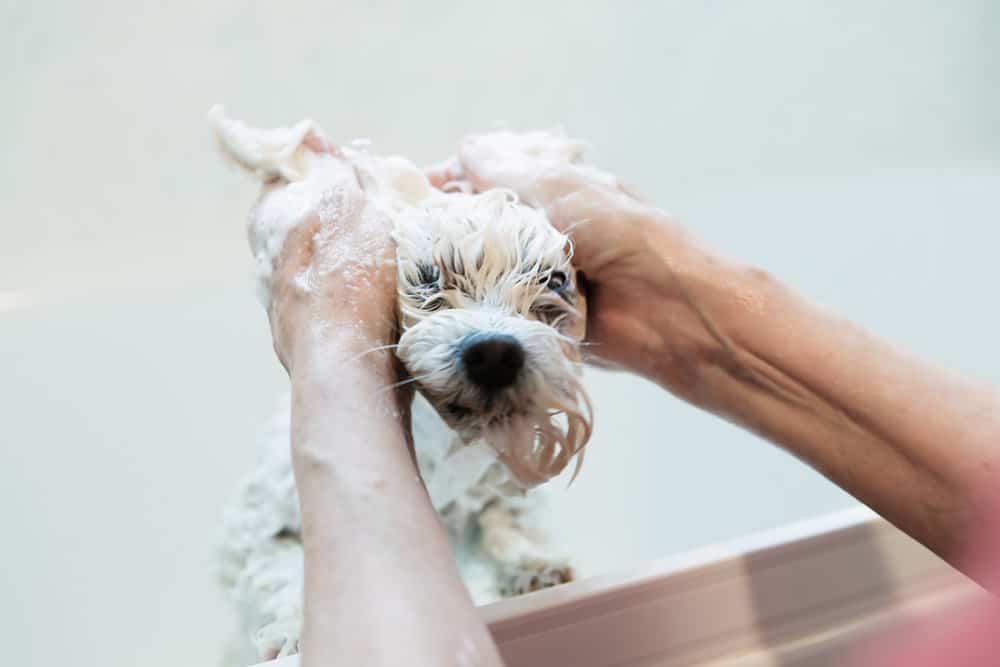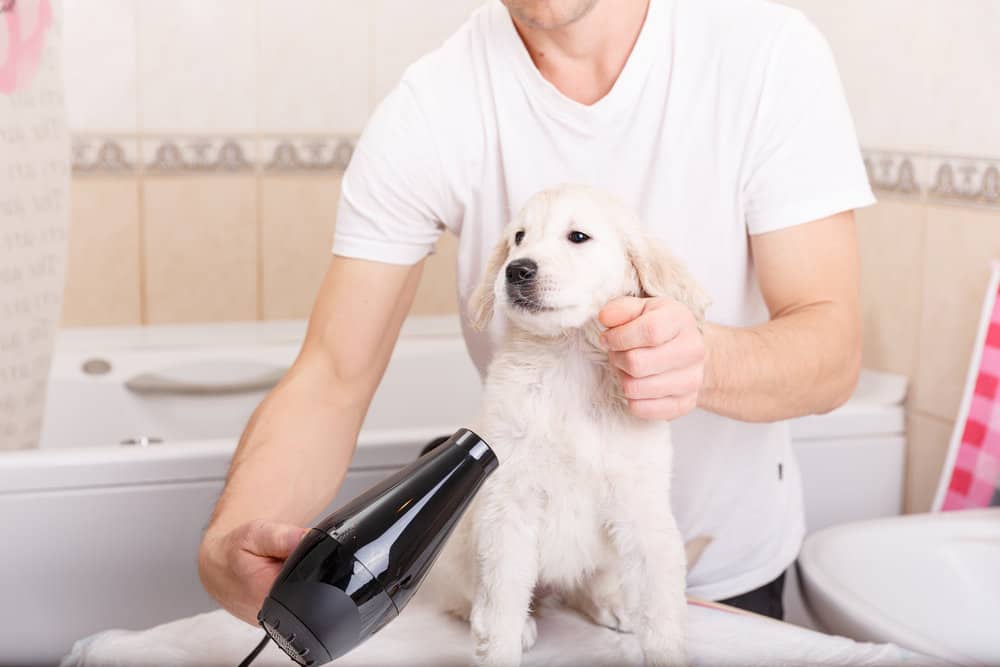Your two-month-old puppy can definitely enjoy a refreshing bath. Just make sure to use puppy shampoo, rinse it thoroughly, along with drying him well and he'll be fine.

Your little trouble-maker got himself into a pickle? Or does he step on his pee so much that his smell no longer matches his cuteness?
In any case, you can rest easy knowing that the answer to “Can I bathe my 2-month-old puppy?” is yes.
Just keep in mind that you'll need to arm yourself with some treats!
How Safe Is It to Bathe My 2-Month-Old Puppy?
It’s completely safe to bathe your 2-month-old puppy without having second guesses. Actually, you can bathe your pup as early as four or six weeks old, but only for major messes.
However, you should never think about bathing a puppy before that.
To explain, canines have an amazing ability to regulate their body temperature through their coat or panting.
That's why, when your dog gets hot, he starts breathing faster in an attempt to expel heat from his body.
Anyway, this ability doesn't become active once they're born. Puppies require some time to begin regulating their body temperature.
Consequently, exposing them to the wrong water temperature during this time can be dangerous.
For example, newborn puppies can develop hypothermia if the water is cold or if they weren't thoroughly dried, especially on cold days.
3 Things to Consider Before Bathing Your Puppy
Before we get into how to bathe your puppy safely, there are three pointers you should keep in mind:
- Make It a Positive Experience
Make every effort to make your little buddy's first bathing experience enjoyable.
Dogs will typically become fearful or anxious about a particular activity if their previous experience was negative. So, here are three ways to make it a pleasant one:

- Use Treats
Keep some treats on hand to give to your little champ as he passes this milestone. If your pup is hesitant to get into the bathroom or sink, place some treats in it to tempt him.
Of course, if he has a favorite rubber toy, that’ll also work just fine.
- Reduce Fear Factors
If you're going to bathe your puppy in the bathtub, remove any empty shampoo bottles first; it's about time anyway!
If those bottles fall, they'll make a loud noise, which can be frightening to your pup. The same is true for any other product in there that can make a sudden loud noise.
Moreover, for your pup's safety, place a non-skid mat where he showers; puppies won't enjoy moonwalking a.k.a. slipping in there.
- Postpone Brushing
Here's the deal: you can brush your dog before the bath only if you brush him at least three times per week. This specifically goes for long-haired breeds with easily tangled hair.
Simply put, brushing out multiple knots in your puppy's hair can be incredibly painful. By doing so before his bath, he'll automatically link this negative emotion with bathing.
So, unless you brush him regularly, postpone it until another time.
- Use Puppy Shampoo
Choose puppy shampoo for bathing because it contains gentle ingredients and has a no-tear formula.
It won't be a problem if you use an adult dog shampoo that you already have. Just make sure that it doesn't contain any harsh chemicals.
If your doggo has sensitive skin, perform a quick safety test. Apply shampoo to a small portion of his leg and observe for any concerning signs.
As for human shampoo, that’ll be a firm no. To clarify, our skin and pH balance are completely different from those of dogs.
Both of our skins are covered by a thin layer known as the acid mantle, which functions to safeguard the top layer.
However, the acid mantle can only function with the proper balance of acidity and alkalinity.
Our pH is more acidic and a human shampoo is specifically formulated to maintain this balance.
Since dogs' pH is more neutral, the chemical additives found in our shampoo disrupt their acid mantle layer, causing:
- Bacterial and parasitic vulnerability
- Flaky and dry skin
- Scratching that leads to wounds
- Use Proper Drying Tools

Make sure you have a couple of towels and a blow dryer ready for when your champ finishes his bath. It's vital to thoroughly dry your puppy so that he doesn't develop a chill.
That's why you'll need two towels; when the first gets wet, use the second to make a warm burrito of him!
When using a blow dryer, keep it on the lowest setting, whether warm or cool.
You should also use it to dry him from a distance, which means that the blow dryer shouldn't be too close to his body.
Naturally, the noise of a blow dryer can startle your pup, but if you sensed that he's truly terrified, put it away.
If you have a smooth-coated buddy, such as a Great Dane, you may not need to go through all these steps. This breed’s coat dries quickly, so stopping at the first towel would do.
How Can I Safely Bathe My Puppy?
Now it's time to walk you through the steps and tips for safely bathing your furball:
- Set the water temperature to lukewarm and test it on your forearm
- Put cotton balls in his ears to keep water out of them
- Bathe him with a cup instead of a sink's tap or showerhead as the noise and water pressure can scare him
- Use a washcloth to clean his face so that water doesn’t get into his eyes
- Apply puppy shampoo and gently massage it on his body with your hands
- Thoroughly rinse him off as any remaining shampoo can irritate his skin and dull his coat
- Dry off your pup completely, and viola, you have a clean pup who's cuter than ever!
How Often Should I Bathe My Puppy?
Bathe your puppy no more than once a month to preserve his natural oils.
Canines groom themselves and their bodies have their own natural oils. Bathing them too often makes them lose their oils and can even cause skin irritation.
However, the frequency with which they bathe can be affected by several factors, one of which is their skin's health.
In some cases of skin allergies, you might need to bathe your pup once a week as it helps relieve the pain and prevent infections.
The breed of your furry friend also influences his showering rate, as smooth-coated dogs may only need to be showered once a year. Whereas, curly-haired dogs, like poodles, may require a bath every two weeks.
Overall, it’s better to consult your veterinarian about the appropriate rate of bathing your doggo.

Paul has been creating content for the dog niche for many years. The information he shares comes his first hand experience growing up in dog lovers household and then owning multiple dog breeds of his own as an adult. Paul enjoys doing the hard research to collect, analyze and present our dogtemperament.com readers with the best answers to their questions.